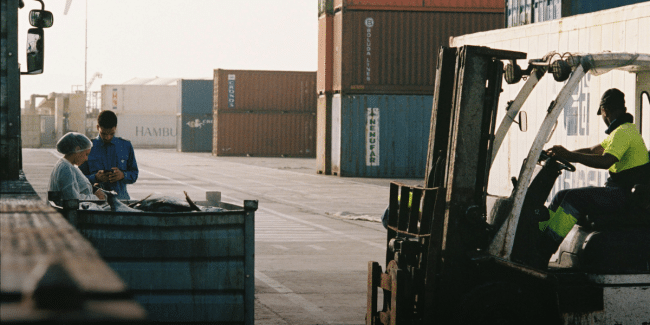
Container Transloading 101: What is Transloading in Logistics?
When freight professionals talk about efficiency, transloading is often part of the conversation. The process is about aligning cargo, equipment, and schedules so goods move seamlessly from ocean vessels to trucks, railcars, or other transport.
Done right, it can shave hours off delivery times, avoid unnecessary storage costs, and keep shipments moving even when plans change. Those who’ve been in the industry for years will tell you: successful transloading starts with a plan and ends with a cargo load that’s optimized for its next leg of the journey.
Transloading: All the Facts
Transloading is the transfer of goods from one mode of transportation or loading unit to another, most commonly from ocean containers to domestic truck trailers or railcars. Unlike cross-docking, which typically involves direct transfer without storage, transloading may involve partial consolidation, deconsolidation, or pallet reconfiguration. It is used when freight arrives in an equipment type incompatible with its final domestic transport requirements.
What is Transloading in Logistics?
Transloading in logistics can usually be broken down into 4 steps:
- Receiving inbound containers at a port or inland terminal.
- Breaking down the cargo load, either floor-loaded or palletized.
- Reconfiguring the load to match domestic freight standards (e.g., 53’ trailers, 40’ domestic containers).
- Transferring freight onto the next transport mode, such as OTR (over-the-road) trucking or intermodal rail.
Container Transloading
Container transloading often takes place within a Free Trade Zone (FTZ) or bonded facility to defer customs clearance until required. There are many common triggers for container transloading.
- Container transloading is often used to maximize the cubic capacity of domestic equipment for cost efficiency.
- It is frequently performed to split shipments for distribution to multiple consignees.
- The process allows for switching from ocean chassis to rail well cars or over-the-road trailers as needed.
- It can involve removing dunnage, bracing, or export packaging that is no longer required.
- Smaller shipments can be consolidated into a single unit for efficiency.
- Hazardous materials can be separated during the process to comply with regulations.

How do labor availability and skill levels affect transloading turnaround times?
Skilled labor with experience in varied cargo handling techniques significantly shortens turnaround times and reduces the risk of damage during transfer.
Comparing the Types of Transloading
Transloading operations vary depending on cargo type, transport modes involved, and supply chain objectives:
| Type | Description | Usage Examples |
| Ocean-to-Truck Transloading | Stripping goods from international containers and loading into domestic trailers. | Inland distribution from port to regional DCs or end customers. |
| Ocean-to-Rail Transloading | Moving freight from port terminals to unit trains for long-haul inland transport. | Bulk freight or large containerized shipments to inland hubs. |
| Truck-to-Rail Transloading | Consolidating regional truck freight into railcars. | Lower-cost long-distance transport. |
| Rail-to-Truck Transloading | Transferring goods from railcars to trucks for final-mile delivery. | Bulk commodities, oversized freight, manufactured goods. |
| Bulk Commodity Transloading | Using pneumatic conveyors, augers, or pumps to transfer bulk solids, liquids, or powders. | Grain, cement, liquids, chemicals. |
| Temperature-Controlled Transloading | Transferring perishable or sensitive goods using reefer units and temperature monitoring. | Food, pharmaceuticals, biotech materials. |
Benefits, Decision Triggers, and Challenges in Transloading
Why and When Transloading Works Best
- Maximized equipment utilization – domestic 53’ trailers can carry more than a 40’ ocean container, reducing the number of linehaul moves.
- Lower costs – avoid extended chassis rentals, port storage fees, and unnecessary backhauls.
- Operational flexibility – reroute freight midstream to match shifting demand or bypass congested terminals.
- Mode shift efficiency – transition between ocean, rail, and truck quickly for optimal inland transport.
- Strategic fit – works well for high-cube freight, multi-stop distribution needs, or mode changes to suit final-mile requirements.
M&M Insight: The best ROI often comes from a combination of higher fill rates and fewer empty miles.
Obstacles in Transloading Operations
- Risk of cargo damage – multiple handling steps can increase exposure.
- Complex scheduling – requires alignment between dray carriers, facilities, and long-haul transport.
- Regulatory compliance – hazmat, weight limits, and customs requirements must be met without error.
M&M Insight: Maintaining an updated compliance checklist and training staff regularly can prevent most regulatory issues.
How M&M Milling Handles Container Transloading
M&M Milling is a trusted toll processing provider operating versatile warehousing and transload facilities with direct access to major ports and rail ramps. So, if your supply chain requires container transloading to meet delivery schedules or optimize freight movement, M&M Milling can help! As one of the best toll processing companies around, we offer various powder processing services such as milling, drying, blending, and sizing.
Contact our team today to schedule a consultation and learn more about M&M Milling’s bulk material handling services.